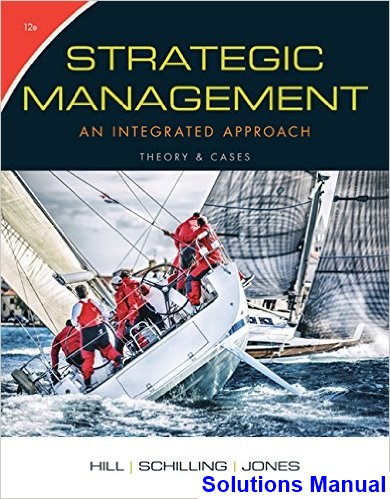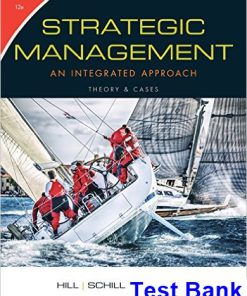Strategic Management Theory and Cases An Integrated Approach 12th Edition Hill Solutions Manual
$35.00 Original price was: $35.00.$26.50Current price is: $26.50.
Strategic Management Theory and Cases An Integrated Approach 12th Edition Hill Solutions Manual
Instant download Strategic Management Theory and Cases An Integrated Approach 12th Edition Hill Solutions Manual pdf docx epub after payment.

Product details:
- ISBN-10 : 1305502272
- ISBN-13 : 978-1305502277
- Author: Charles W. L. Hill; Melissa Schilling
This comprehensive and engaging text presents the complexities of strategic management through up-to-date scholarship and hands-on applications. Highly respected authors Hill, Schilling, and Jones integrate cutting-edge research on topics including competitive advantage, corporate governance, diversification, strategic leadership, technology and innovation, and corporate social responsibility through both theory and case studies. Based on real-world practices and current thinking in the field, the 12th edition features an increased emphasis on the changing global economy and its role in strategic management. The appendix walks students through the case-analysis process, and explains key ratios that managers use to compare the performance of firms. The high-quality case study program contains 31 cases covering small, medium, and large companies from a large range of industries and nations. Featured cases in this edition include Tesla Motors, India’s Tata Group, Sangamo’s development of a gene editing cure for HIV, Skullcandy, Uber, Microsoft, Google, and Staples. When paired with this student-centric text, the MindTap learning solution will prepare the next generation of strategic leaders.
Table Of Contents:
- Part 1: Introduction to Strategic Management
- Chapter 1: Strategic Leadership: Managing the Strategy-Making Process for Competitive Advantage
- 1-1 Overview
- 1-2 Strategic Leadership, Competitive Advantage, and Superior Performance
- 1-3 Strategic Managers
- 1-4 The Strategy-Making Process
- 1-5 Major Goals
- 1-6 Strategy as an Emergent Process
- 1-7 Strategic Planning in Practice
- 1-8 Strategic Decision Making
- 1-9 Strategic Leadership
- Key Terms
- Takeaways for Strategic Managers
- Appendix to Chapter 1: Enterprise Valuation, ROIC, and Growth
- Notes
- Chapter 2: External Analysis: The Identification of Opportunities and Threats
- 2-1 Overview
- 2-2 Defining an Industry
- 2-3 Porter’s Competitive Forces Model
- 2-4 Strategic Groups within Industries
- 2-5 Industry Life-Cycle Analysis
- 2-6 Limitations of Models for Industry Analysis
- 2-7 The Macroenvironment
- Key Terms
- Takeaways for Strategic Managers
- Notes
- Part 2: The Nature of Competitive Advantage
- Chapter 3: Internal Analysis: Resources and Competitive Advantage
- 3-1 Overview
- 3-2 Competitive Advantage
- 3-3 Value Creation and Profitability
- 3-4 The Value Chain
- 3-5 The Building Blocks of Competitive Advantage
- 3-6 Analyzing Competitive Advantage and Profitability
- Key Terms
- Takeaways for Strategic Managers
- Notes
- Chapter 4: Competitive Advantage through Functional-Level Strategies
- 4-1 Overview
- 4-2 Achieving Superior Efficiency
- 4-3 Achieving Superior Quality
- 4-4 Achieving Superior Innovation
- 4-5 Achieving Superior Customer Responsiveness
- Key Terms
- Takeaways for Strategic Managers
- Notes
- Part 3: Strategies
- Chapter 5: Business-Level Strategy
- 5-1 Overview
- 5-2 Low Cost and Differentiation
- 5-3 Who Are Our Customers? Market Segmentation
- 5-4 Business-Level Strategy Choices
- 5-5 Business-Level Strategy, Industry, and Competitive Advantage
- 5-6 Implementing Business-Level Strategy
- 5-7 Competing Differently: Blue Ocean Strategy
- Key Terms
- Takeaways for Strategic Managers
- Notes
- Chapter 6: Business-Level Strategy and the Industry Environment
- 6-1 Overview
- 6-2 Strategy in a Fragmented Industry
- 6-3 Strategies in Embryonic and Growth Industries
- 6-4 Strategy in Mature Industries
- 6-5 Strategies in Declining Industries
- Key Terms
- Takeaways for Strategic Managers
- Notes
- Chapter 7: Strategy and Technology
- 7-1 Overview
- 7-2 Technical Standards and Format Wars
- 7-3 Strategies for Winning a Format War
- 7-4 Costs in High-Technology Industries
- 7-5 Capturing First-Mover Advantages
- 7-6 Technological Paradigm Shifts
- Key Terms
- Takeaways for Strategic Managers
- Notes
- Chapter 8: Strategy in the Global Environment
- 8-1 Overview
- 8-2 Global and National Environments
- 8-3 Global Expansion, Profitability, and Profit Growth
- 8-4 Cost Pressures and Pressures for Local Responsiveness
- 8-5 Choosing a Global Strategy
- 8-6 The Choice of Entry Mode
- 8-7 Global Strategic Alliances
- Key Terms
- Takeaways for Strategic Managers
- Notes
- Chapter 9: Corporate-Level Strategy: Horizontal Integration, Vertical Integration, and Strategic Out
- 9-1 Overview
- 9-2 Corporate-Level Strategy and the Multibusiness Model
- 9-3 Horizontal Integration: Single-Industry Corporate Strategy
- 9-4 Vertical Integration: Entering New Industries to Strengthen the “Core” Business Model
- 9-5 Alternatives to Vertical Integration: Cooperative Relationships
- 9-6 Strategic Outsourcing
- Key Terms
- Takeaways for Strategic Managers
- Notes
- Chapter 10: Corporate-Level Strategy: Related and Unrelated Diversification
- 10-1 Overview
- 10-2 Increasing Profitability through Diversification
- 10-3 Two Types of Diversification
- 10-4 The Limits and Disadvantages of Diversification
- 10-5 Choosing a Strategy
- 10-6 Entering New Industries: Internal New Ventures
- 10-7 Entering New Industries: Acquisitions
- 10-8 Entering New Industries: Joint Ventures
- Key Terms
- Takeaways for Strategic Managers
- Notes
- Part 4: Implementing Strategy
- Chapter 11: Corporate Governance, Social Responsibility, and Ethics
- 11-1 Overview
- 11-2 Stakeholders and Corporate Performance
- 11-3 Agency Theory
- 11-4 Governance Mechanisms
- 11-5 Ethics and Strategy
- Key Terms
- Takeaways for Strategic Managers
- Notes
- Chapter 12: Implementing Strategy through Organization
- 12-1 Overview
- 12-2 Organizational Architecture
- 12-3 Organizational Structure
- 12-4 Organization Controls and Incentives
- 12-5 Organizational Culture
- 12-6 Organization Processes
- 12-7 Implementing Strategy through Organizational Architecture
- Key Terms
- Takeaways for Strategic Managers
- Notes
- Part 5: Cases in Strategic Management
- Introduction: Analyzing a Case Study and Writing a Case Study Analysis
- What Is Case Study Analysis?
- Analyzing a Case Study
- Writing a Case Study Analysis
- The Role of Financial Analysis in Case Study Analysis
- Conclusion
- Endnote
- Long Cases
- Case 1: Trader Joe’s in 2018
- Case 2: Small Package Express Delivery Industry, 1973-2018
- Case 3: Airborne Express: The Underdog
- Case 4: Charles Schwab
- Case 5: Coca-Cola
- Case 6: Uber in 2018
- Case 7: Dell Inc (A)-Going Private
- Case 8: Dell Inc (B)-Transforming the Company
- Case 9: Apple at Fourty
- Case 10: Wal-Mart Stores
- Case 11: Costco Wholesale Corporation in 2018
- Case 12: SpaceX: Disrupting the Space Industry
- Case 13: Alibaba Group: The Rise of a Platform Giant
- Case 14: Ending HIV? Sangamo and Gene Editing
- Case 15: Tesla, Inc. in 2018
- Case 16: Chotukool: Challenges and Opportunities in Frugal Innovation
- Case 17: IKEA in 2018: Furniture Retailer to the World
- Case 18: General Electric
- Case 19: 3M: The Innovation Engine
- Case 20: Nike: The Sweatshop Debate 20 Years on
- Short Cases
People also search:
|
strategic management theory and cases an integrated approach
|
strategic management theory & cases an integrated approach 13th edition
strategic management theory & cases an integrated approach 11th edition
strategic management theory & cases an integrated approach 13e
You may also like…
Solution Manual
Solution Manual for Cases in Strategic Management An Integrated Approach 9th Edition by Hill
Solution Manual
Strategic Management Theory & Cases An Integrated Approach Hill 11th Edition Solutions Manual
Solution Manual
Test Bank
Test bank for Strategic Management: Theory & Cases: An Integrated Approach 12th Edition by Hill












